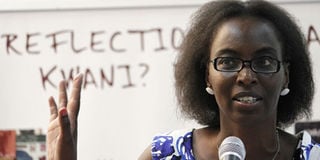Adhiambo’s ‘Dust’ best depicts the place of the historical novel

Author Yvonne Adhiambo Owuor gives a speech during a celebratory event to mark KWANI?'s 10 year Anniversary at the KU business centre conference November 28, 2013. PHOTO | EMMA NZIOKA | NATION MEDIA GROUP
What you need to know:
Metaphorically, Odidi is like Kenya, which after the dazzling neon promise of Independence, degenerated into something unrecognisable, sometimes terrifying.
Odidi’s death touches off a chain of events: scrambles his mother’s sanity, mutes and confuses his father and opens a Pandora’s Box of unending secrets. Odidi’s sister, Ajany, flies in from overseas on hearing of his brother’s death.
And this is where Kenya’s history, its darkest hour, is unveiled.
“Powerlessness is hearing a father’s deep voice become a wail,” writes Yvonne Adhiambo Owuor (pictured) in her debut novel, Dust.
Owuor writes deftly; something purposeful in the speed and fierce passion of her pen, like the way a scorned wife wields a knife when stabbing an errant husband and continues to stab long after he has died.
Yvonne looks at Kenya with the pathos with which a man looks at a beggar shuffle away into a street corner after giving him only a few coins and then suddenly wishing he had given more.
Maybe that’s why she passionately wrote and wrote and wrote, giving us a magnus opus that is Tolstoyan in its grasp of history and in its ability to highlight the real issues affecting Kenya.
Hope rises, in a few glowing instants, then death. Like Kenya, beaming with promise at Independence, the young, handsome character named Odidi is beaming with promise.
He dazzled his professors at university with his brilliance when he was studying engineering. However, as the novel starts, Odidi is running for his life. How the luminous Odidi turns into the bleeding and dying man after being shot by the police is one of the most heart rending things to ever happen.
Metaphorically, Odidi is like Kenya, which after the dazzling neon promise of Independence, degenerated into something unrecognisable, sometimes terrifying.
Odidi’s death touches off a chain of events: scrambles his mother’s sanity, mutes and confuses his father and opens a Pandora’s Box of unending secrets. Odidi’s sister, Ajany, flies in from overseas on hearing of his brother’s death.
And this is where Kenya’s history, its darkest hour, is unveiled.
WIDE, SWOOPING TURN
Ajany flies into the country when the post-election violence has started. The narrative takes a wide, swooping turn and heads into a world of unending grief and tears; the country sinking into a timeless night “on a day when distorted election results will set a bucolic country afire”.
She continues: “The outside world is drenched with human noises of accusations and counter-accusations, election rigging, and the miracle of mathematical votes that multiply and divide themselves. But within their world, in a self-contained, haunted compound with its lone, misshapen grevillea tree, upon which a purple-blue bird tweets, and where death prowls at half past three, Ajany bends forward to listen to and for her brother, Odidi, whose story-words had created vessels that always carried her into safe border”.
One of the major takeaways for writers from Owuor’s book is that writers can create yarns from real historical events and figures and then add a fictitious touch.
She does not shy away from our history, even the ugly parts. She writes that like Odidi’s death, the country’s “dying had started long ago.
Long before the murder of prophets named Pio, Tom, Argwings, Ronald, Kungu, Josiah, Ouko, Mbae. The others, the ‘disappeared unknown’. National doors slammed over vaults of secrets; threat loomed.
The wise chose cowardice, a way of life: not hearing, not seeing, never asking, because sound, like dreams, could cause death” in a country whose official languages are “English, Kiswahili, and Silence.”
She recreates the post-election violence in Kenya in 2007/08 when a man “named Kofi Annan” is sent to “save Kenya”. “Kofi in turn invited ‘Haninant Parsons’”. The character doesn’t know how to pronounce “Eminent Persons” so it’s corrupted to “Haninant Parsons”.
Another character, Nyipir, asks, “What news of Agwambo?” Another one asks about “Chibaki-do you know him?” Of course, we can see Kofi Annan, Agwambo (the former Prime Minister, Hon Raila Odinga) and H.E Mwai Kibaki in all this.
The second takeaway for writers is the beauty of wordplay, delivered in short, poetic sentences. “Odidi runs. Tears flood. Terror-rage-love fuse. The fallen ones are his men. Guilt. Fury. Sorrow”. Describing the Nairobi sky, she waxes lyrical, “Massive purple clouds rush in from the eastern coast. Ambushed by a warm wind in Nairobi, they scatter, a routed guerrilla force”.
Kenyan writers should learn from Owuor. They can create enduring tomes from our national history from the Mau Mau uprising, the Nandi resistance and other resistant groups, political assassinations, the post-election violence and the day-to-day drama in our political theatrics.





